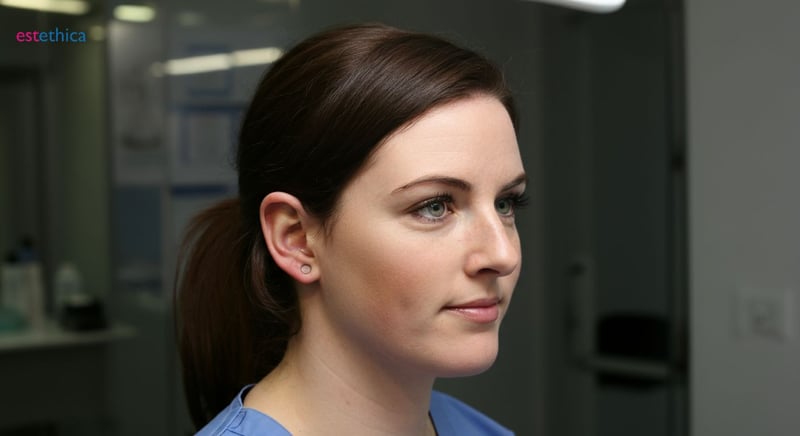Unlock Your Confidence: The Ultimate Guide to Otoplasty
Discover how otoplasty can reshape your ears and boost your confidence with estethica's expert care.
Otoplasty, often referred to as ear surgery, is a transformative procedure designed to correct prominent ears and enhance the overall appearance of the ear structure. It offers individuals the opportunity to boost their self-esteem and achieve the facial harmony they desire. At estethica, a pioneer in aesthetic surgeries, otoplasty is performed under the guidance of expert surgeons employing advanced techniques to ensure patient safety and satisfaction. This guide will serve as your comprehensive resource on otoplasty, diving deep into the causes of prominent ears, the surgical journey, recovery tips, and even non-surgical alternatives.
Understanding Prominent Ears: Causes and Solutions
Exploring Non-Surgical Solutions for Prominent Ears
For those hesitant about surgery, non-surgical options offer a less invasive approach to addressing prominent ears. These methods can be particularly appealing for children or individuals seeking minimal downtime. One popular technique involves the use of ear molding devices, which are most effective when applied during infancy. These devices gently reshape the ear cartilage over time, reducing prominence.
- Ear molding devices: Effective for infants, these devices gradually reshape ear cartilage.
- Clip-on ear correctors: Suitable for temporary use, they provide a quick aesthetic fix.
- Camouflage techniques: Hairstyles or accessories can help conceal prominent ears.
While these methods may not offer permanent solutions, they provide valuable alternatives for those exploring non-invasive options. For instance, clip-on ear correctors can be used for special occasions, offering a temporary aesthetic improvement without commitment.
Surgical Interventions: Understanding Otoplasty
Otoplasty, a common surgical procedure, is designed to permanently correct prominent ears. This surgery involves reshaping the ear cartilage to create a more natural appearance. Typically performed on children and adults, otoplasty can significantly boost self-confidence by aligning the ears closer to the head.
- Consultation: Discuss goals and expectations with a qualified surgeon.
- Procedure: The surgeon reshapes the cartilage, often under local anesthesia.
- Recovery: Patients usually resume normal activities within a week.
Otoplasty is highly customizable, allowing surgeons to tailor the procedure to individual needs. For example, some patients may require only minor adjustments, while others might need more extensive reshaping. Understanding the process and potential outcomes is essential for anyone considering this transformative surgery.

What to Expect During Your Otoplasty Consultation
Key Aspects of the Otoplasty Consultation
During an otoplasty consultation, the surgeon will assess your ear structure and discuss potential outcomes. This session is crucial for tailoring a personalized surgical plan that aligns with your aesthetic goals. It's an opportunity to understand the benefits and risks associated with ear surgery.
- Evaluation of ear structure: The surgeon examines the ears to determine the best approach.
- Discussion of goals: Patients can express their desired outcomes and expectations.
- Explanation of risks: Understanding potential complications is vital for informed decision-making.
Being prepared with questions can enhance the consultation experience. For example, asking about the surgeon's experience with otoplasty or inquiring about recovery timelines can provide valuable insights. This proactive approach ensures a comprehensive understanding of the procedure.
Understanding the Otoplasty Process
The otoplasty process involves several stages, each critical to achieving the desired results. Understanding these steps can help patients feel more comfortable and informed about the journey ahead.
- Initial Consultation: Discuss your goals and undergo a thorough ear examination.
- Surgical Planning: The surgeon outlines a customized plan based on your unique needs.
- Post-Consultation Preparation: Receive guidelines on how to prepare for the surgery day.
Each step in the otoplasty process is designed to ensure patient safety and satisfaction. For instance, the surgical planning phase allows for adjustments based on individual ear anatomy, ensuring a natural and harmonious result. Understanding these phases can alleviate anxiety and foster confidence in the procedure.

Recovery Insights: Healing After Ear Surgery
Essential Post-Operative Care Tips
Post-operative care is crucial for a successful recovery after otoplasty. Patients often experience mild discomfort or swelling, which typically subsides within a few days. Adhering to the surgeon's guidelines, such as wearing a protective headband, can significantly aid in the healing process.
- Protective headband: Essential for maintaining ear position and reducing swelling.
- Avoiding strenuous activities: Helps prevent complications and promotes healing.
- Regular follow-ups: Ensures proper recovery and addresses any concerns promptly.
Following these tips can enhance recovery outcomes. For instance, wearing a headband consistently helps maintain the new ear shape, while avoiding physical exertion minimizes the risk of injury. Regular follow-ups with the care team ensure any issues are addressed swiftly, promoting a smooth recovery.
Understanding the Recovery Timeline
The recovery timeline for otoplasty varies among individuals, but understanding the general phases can help set realistic expectations. Typically, patients can resume normal activities within a week, although complete healing may take several weeks.
- Initial Days: Focus on rest and follow post-operative instructions closely.
- First Week: Swelling and discomfort begin to decrease; light activities may resume.
- Long-Term: Full recovery and stabilization of ear shape occur over several weeks.
Each phase of recovery is essential for achieving optimal results. For example, the initial days are critical for minimizing swelling, while the first week allows for gradual reintroduction of daily activities. Understanding this timeline helps patients manage their recovery journey effectively.

Exploring Non-Surgical Alternatives for Ear Correction
Innovative Non-Surgical Techniques for Ear Correction
Non-surgical ear correction methods have gained popularity for their minimal invasiveness and effectiveness. These techniques cater to individuals seeking alternatives to traditional ear surgery, such as otoplasty. One innovative approach is ear molding for infants, which gently reshapes the ear cartilage during the early stages of development. This method is most effective when applied within the first few weeks after birth, capitalizing on the pliability of infant cartilage.
- Ear molding for infants: Utilizes soft molds to reshape cartilage, ideal for newborns.
- Minimally invasive procedures: Offer subtle enhancements without incisions.
- Non-surgical ear clips: Provide temporary aesthetic improvements for adults.
These non-surgical options provide viable alternatives for those hesitant about surgery. For example, minimally invasive procedures can involve the use of sutures or clips to adjust ear positioning, offering a less permanent solution compared to otoplasty. Additionally, non-surgical ear clips are popular among adults seeking temporary changes for special occasions.
Evaluating the Effectiveness of Non-Surgical Ear Correction
When considering non-surgical ear correction, it's crucial to evaluate the effectiveness and suitability of each method. While these techniques offer less invasive options, their outcomes may vary based on individual needs and expectations. Consulting with a specialist can help determine the best approach for achieving desired results.
- Initial Consultation: Discuss goals and assess ear structure with a specialist.
- Technique Selection: Choose the most appropriate non-surgical method based on individual needs.
- Follow-Up: Monitor progress and make adjustments as necessary for optimal results.
Each step in the evaluation process is essential for ensuring satisfaction with non-surgical ear correction. For instance, the initial consultation allows for a thorough assessment of ear structure, guiding the selection of the most suitable technique. Regular follow-ups ensure that any necessary adjustments are made, enhancing the overall effectiveness of the chosen method.
Advanced Otoplasty Techniques for Enhanced Facial Harmony
Comprehensive Recovery Support for Optimal Healing
Frequently Asked Questions
What is otoplasty and how does it help with prominent ears?
How long does the recovery process take after otoplasty?
Are there non-surgical alternatives for correcting prominent ears?
Is ear surgery safe and what are the potential risks?
What should I expect during an otoplasty consultation?
Discover the path to your healthiest and most beautiful self with estethica's award-winning services. Call now for a free consultation and take the first step towards a new you!
📞 Call for Your Free Consultation Today!